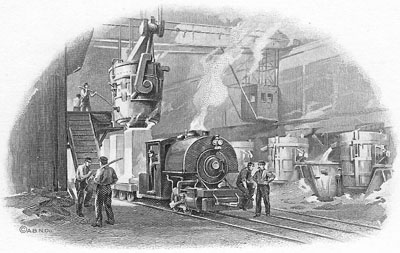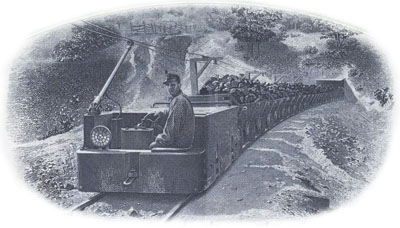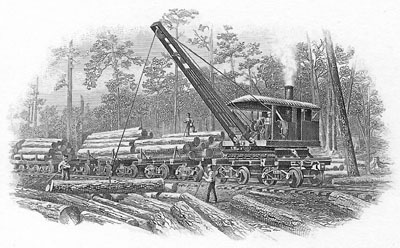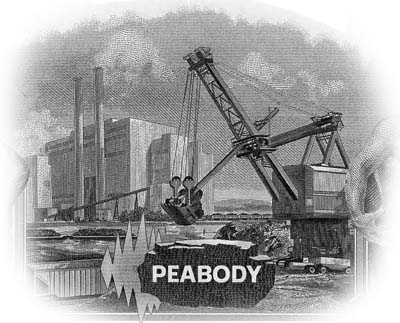Non-railroads that used rail
This project endeavors to list only certificates that came from companies within the railroad industry. Even more companies existed on the periphery of the industry. The problem is defining the railroad industry. It is often impossible to determine whether companies on the periphery played measurable roles in railroading. Rightly or wrongly, the primary determinant for this project is company name.
When faced with the question of whether a specific company is going to be listed or not, simply ask,
"Would this company be listed in a
CATALOG FOR ANOTHER INDUSTRY?"
(if one existed)
If "yes," then the company probably does not belong here.
Manufacturing and industrial railroads are excluded unless operations were incorporated as separate railroad companies.

There were thousands, probably tens of thousands, of manufacturers that used some sort of railroad equipment to move products around their facilities. Their rail equipment was as variable as the products they produced. They used full-sized equipment and small equipment, heavy rails and light-weight rails. While thousands of manufacturing companies used railroad equipment, very few collectors would consider them "railroad companies." Most did not carry freight or passengers off their own sites.
Many people collect certificates from companies that produced crucial railroad — equipment such as locomotives, cars, switches, and signals. Certificates from those kinds of manufacturers are obvious inclusions to many collections.
But, how far beyond those kinds of companies would most collectors stretch the definition of "railroading."
Mining railroads are excluded unless operations were incorporated as separate railroad companies.

Mining operations moved tremendous tonnages of material and frequently depended entirely on railroad equipment, both on the surface and underground. In some gold and silver mines, ore was shoveled into mine cars within a few feet of where miners had blasted rock loose. Between there and a smelter, ore might have moved exclusively across rails with only short intermissions as it passed through crushers or mills. I suggest that 75% or more of every ton of ore or coal mined in North America saw the inside of some kind of rail car before conversion into final products
In many operations, mine cars carried raw material directly from the working face to waiting rail cars. Every operation was different, so distances of rail transport might have ranged from a few hundred feet to a few miles. Economics normally dictated that the greater the distances involved, the larger the rail equipment. Depending on the size of mining operations, railroad companies extended their trackage as close as possible to mining properties. Transload facilities were often located on land owned by mining companies or on leased land nearby.
In some cases, topography, locations of ore deposits or economics prevented extensions of rail lines, so companies laid their own track and carried ore over long distances in their own rail equipment. Once companies began laying rails across land they did not own, companies often formed their own transportation companies and named those separate operations with some variation of "railroad" in their names. Companies like that are included in this project whereas private rail operations are excluded. It is possible that a few private mine-owned rail operations survive in this database because I was unable confirm their corporate status.
I remind collectors that just because a mining company owned track and a couple locomotives does not make it a railroad company. If a certificate carries the name of a mining company, but does not include "railroad" or "railway" in the official corporate name, I classify it as a mining company.
Logging railroads are excluded unless operations were incorporated as separate railroad companies.

Logging, timber and lumber companies laid thousands upon thousands of miles of track in North America, practically anywhere large trees grew. Equipment tended to be narrow gauge, although very wide-gauge equipment was used in parts of California, Washington, and Oregon. Much railroad equipment used by loggers was bought secondhand from genuine railroad companies. A few large logging companies bought their own custom locomotives.
Companies often operated on branches for a few years, pulled up track and re-laid it elsewhere. Logging railroads were numerous across the continent, but their lines shifted frequently. There are numerous books on logging railroads, but few logging railroads are included in the railroad database for a couple of reasons.
Like mining companies, logging railroads existed to move heavy logs from hillsides to saw mills. Only a small number ever incorporated rail operations separate from parent logging companies, so only a few actually qualify as "railroad companies."
For several years, I cataloged logging railroads among legitimate railroad companies. Only a few certificates are known and they in the first edition of Stocks and Bonds of North American Railroads. The first edition attracted many contributions from readers, but none ever corresponded about logging railroads. Not one! As a consequence, I ceased recording logging railroads unless they used railroad keywords in their company names. Those excluded logging, lumber, timber companies can now be found among the long list at non-railroad companies.
Plantation railroads are excluded unless operations were incorporated as separate railroad companies.
Like logging and mining companies, large plantation companies often used rail transportation to move their products from remote fields and onto main lines. Gauges tended to range from 18 inches to one meter. These kinds of captive operations were especially common in Cuba, the southern United States and Hawaii with several more in Central America. While plantations used railroad equipment, they rarely carried freight or passengers except as needed for their own purposes. Even if they did, plantations were still farming operations and not transportation companies.
A few plantations were included in the first and second editions of my catalog. Since then, I have removed all plantation railroads except those that used the word "railroad" or "ferrocarril" in their names. Rightly or wrongly, I decided that very few average collectors would ever think of looking for information about plantation certificates in a book titled Collectible Stocks and Bonds of North American Railroads.
Street railways owned by utilities are excluded unless rail operations were incorporated as separate companies.

I have covered this industry extensively elsewhere, particularly at a page titled What about utilities?
In truth, utility companies are peculiar because many operated in two industries at the same time; they generated profits carrying passengers on street railways and interurbans while most of their income came from sales of electricity.